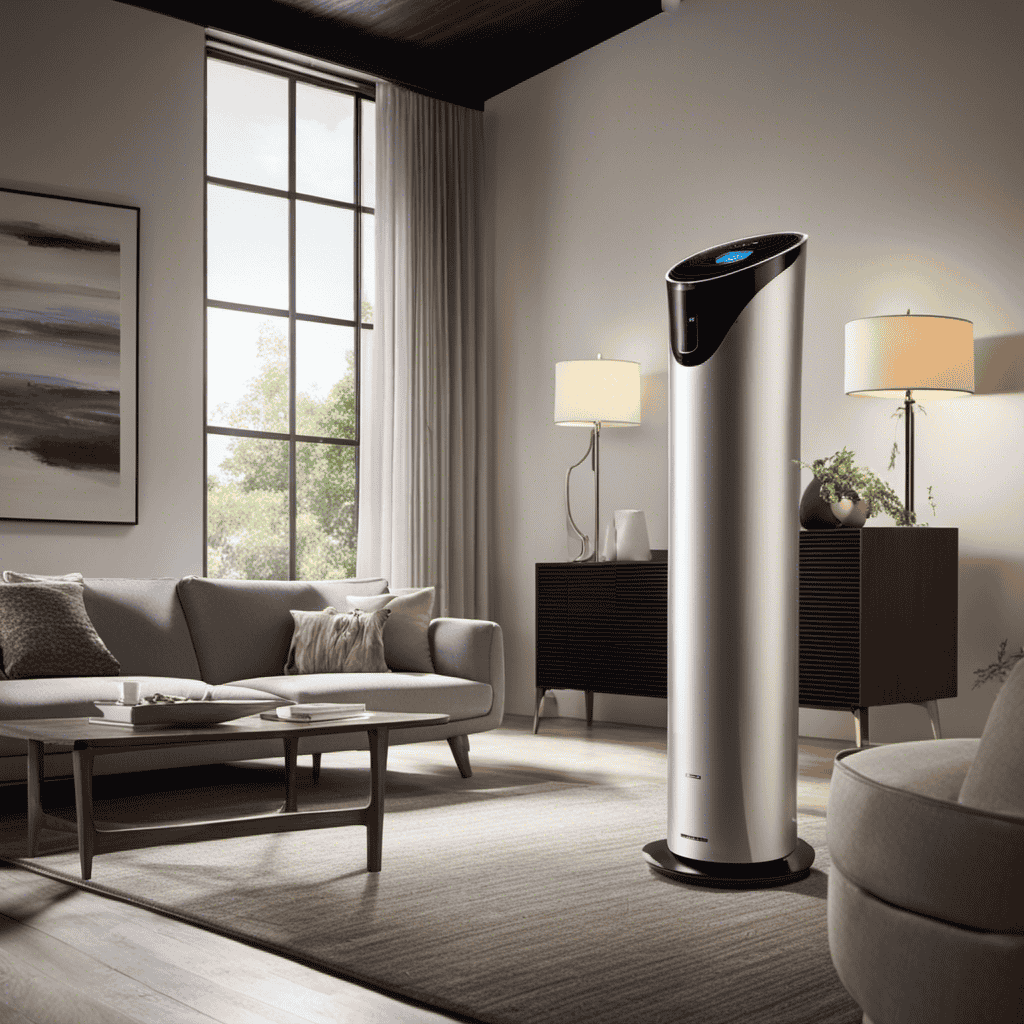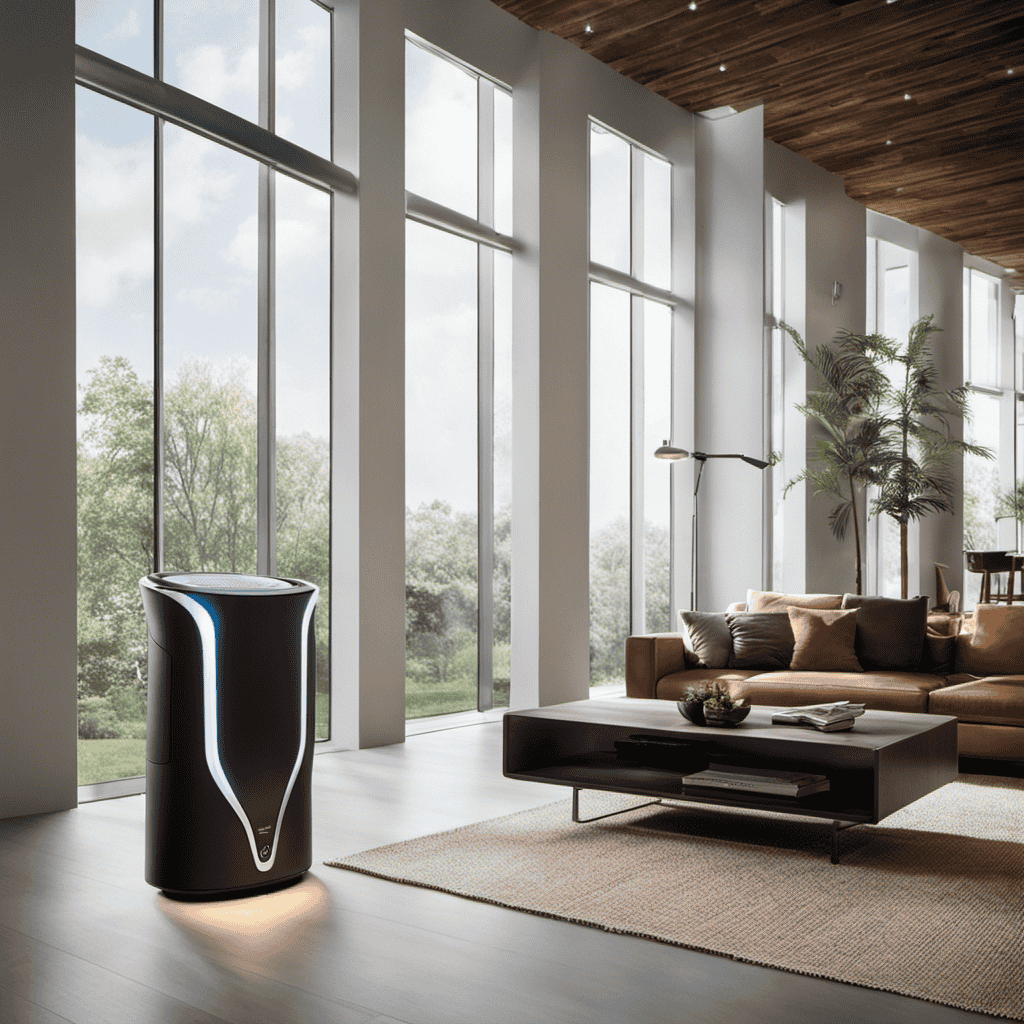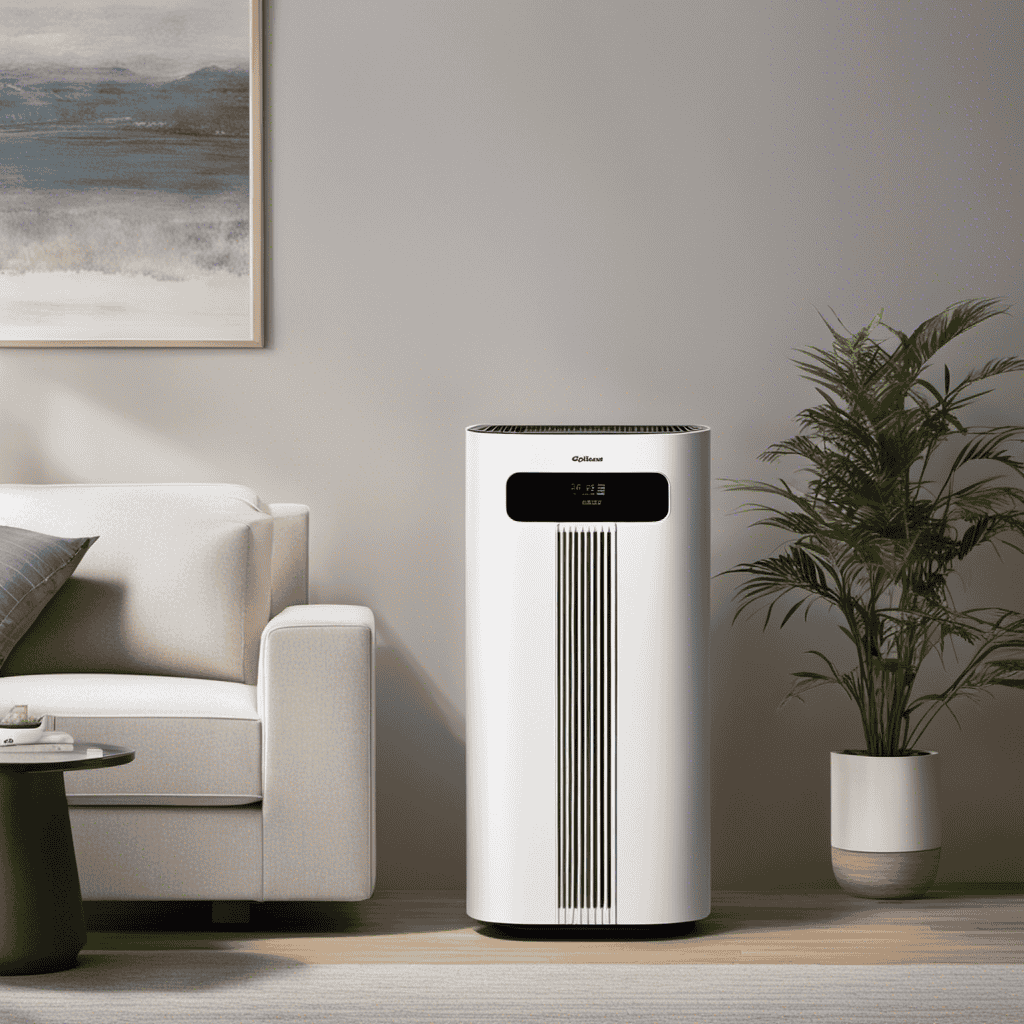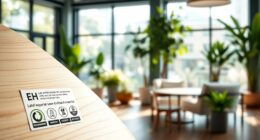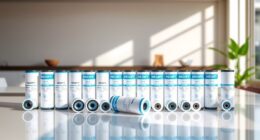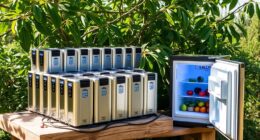Being someone who has dealt with allergies and respiratory problems myself, I truly appreciate the value of having clean air. That’s why I was fascinated when I first discovered air purifiers.
These devices promise to remove harmful pollutants from the air, providing a breath of fresh air in our homes.
In this article, we will explore what air purifiers are, how they work, and the benefits they offer.
So, if you’re curious about how to improve your indoor air quality, keep reading to discover the world of air purifiers.
Key Takeaways
- Air purifiers function as filters that remove particles and pollutants from the air.
- Using an air purifier creates cleaner indoor air by removing contaminants and allergens.
- Air purifiers improve overall air quality and make the environment healthier.
- Factors to consider when choosing an air purifier include the filter type, effectiveness in removing particles, room size, and noise level.
Types of Air Purifiers
If you’re looking for an air purifier, you’ll find that there are different types available on the market. When it comes to air purifier maintenance, it’s important to consider the type of unit you choose.
Some types require more frequent filter changes or cleaning than others. For example, HEPA filters, which are known for their high efficiency in removing airborne particles, typically need to be replaced every 6 to 12 months. On the other hand, electrostatic precipitators may require regular cleaning to maintain their effectiveness.
Another factor to consider is air purifier noise levels. While most air purifiers operate quietly, some models can produce noticeable noise, especially at higher fan speeds. It’s important to check the noise levels of the air purifier before making a purchase to ensure it won’t disturb your daily activities or sleep.
How Air Purifiers Work
To understand how they work, you can think of air purifiers as filters that remove particles and pollutants from the air. Air purifiers utilize advanced technology to clean the air, ensuring a healthier and safer indoor environment.
These devices typically consist of a fan that draws air into the unit, passing it through various filters that trap contaminants. The filters used in air purifiers are designed to capture different types of particles, such as dust, pollen, pet dander, and even harmful gases. HEPA filters, for example, are highly effective at capturing small particles as small as 0.3 microns.
When buying an air purifier, consider the size of the room, the type of pollutants you want to remove, and the noise level of the device. Understanding how air purifiers work is crucial in selecting the right one for your needs.
Transitioning into the next section, let’s now explore the benefits of using an air purifier.
Benefits of Using an Air Purifier
Using an air purifier in your home can have several significant benefits.
Firstly, it helps to create cleaner indoor air by removing various contaminants such as dust, pollen, pet dander, and mold spores. This can greatly improve the overall air quality and make the environment healthier to breathe in.
Additionally, air purifiers have been shown to reduce respiratory issues by filtering out particles that can trigger allergies and asthma symptoms.
Cleaner Indoor Air
A high-quality air purifier can help me breathe cleaner air indoors. Indoor air quality is an important factor that affects our health. Poor indoor air quality can lead to various health issues such as allergies, asthma, respiratory problems, and even cardiovascular diseases.
By removing pollutants and allergens from the air, air purifiers can significantly improve the quality of indoor air. Studies have shown that using air purifiers can reduce the concentration of airborne particles, including dust, pollen, pet dander, and mold spores. This can help alleviate symptoms for individuals with allergies or asthma.
Additionally, air purifiers with activated carbon filters can eliminate harmful chemicals and odors, further enhancing the air quality. Breathing cleaner air indoors can have significant health benefits and contribute to overall well-being.
Reduces Respiratory Issues
You’ll notice a decrease in respiratory issues once you start using a high-quality air purifier. Air purifiers are designed to remove harmful particles and pollutants from the air, improving indoor air quality. This can have a significant impact on your respiratory health, reducing the risk of respiratory infections, allergies, and asthma attacks. The benefits of using an air purifier extend beyond respiratory issues and can also improve sleep quality. By removing airborne allergens, such as dust mites and pet dander, air purifiers create a cleaner and healthier sleep environment. This can result in better sleep, reduced snoring, and improved overall sleep quality. Investing in a high-quality air purifier is a proactive step towards safeguarding your respiratory health and enhancing your sleep.
| Air Purifier Benefits | Impact on Sleep Quality |
|---|---|
| Removes harmful particles and pollutants | Creates a cleaner and healthier sleep environment |
| Reduces respiratory infections, allergies, and asthma attacks | Improves overall sleep quality |
| Removes airborne allergens | Reduces snoring |
| Enhances respiratory health | Promotes better sleep |
| Proactive step towards better health | Safeguards sleep quality |
Eliminates Harmful Pollutants
Eliminating harmful pollutants from the air is essential for improving respiratory health and sleep quality. As an individual who suffers from allergies and has worked in commercial settings, I have experienced the positive impact of air purifiers firsthand. Here are some discussion ideas to consider:
-
Impact on allergies:
-
Air purifiers can remove allergens such as pollen, dust mites, and pet dander from the air, reducing allergy symptoms.
-
They can also filter out mold spores, which can trigger allergic reactions in sensitive individuals.
-
Air purifiers in commercial settings:
-
In offices, air purifiers can help create a healthier and more productive work environment by reducing airborne pollutants and improving air quality.
-
In hospitals and healthcare facilities, air purifiers can aid in preventing the spread of infections by removing airborne pathogens.
Scientific evidence supports the effectiveness of air purifiers in eliminating harmful pollutants and improving indoor air quality. With their ability to reduce allergies and enhance air quality in various commercial settings, air purifiers play a crucial role in promoting respiratory health and ensuring a good night’s sleep.
Common Indoor Air Pollutants
One of the most common indoor air pollutants is cigarette smoke. It is well-known that exposure to cigarette smoke can have severe health effects. Studies have shown that it can increase the risk of respiratory problems such as asthma and bronchitis. Additionally, it can also lead to cardiovascular diseases and even lung cancer.
It is important to note that these health effects are not only limited to smokers but also affect non-smokers who are exposed to secondhand smoke. To improve indoor air quality and minimize the health risks associated with cigarette smoke, it is crucial to implement certain tips.
These include banning smoking indoors, ensuring proper ventilation, and using air purifiers specifically designed to filter out harmful particles from the air. By taking these precautions, we can significantly reduce the negative impact of cigarette smoke on our indoor air quality and overall health.
Factors to Consider When Choosing an Air Purifier
When considering an air purifier, two important factors to take into account are the filter type effectiveness and the room size compatibility.
The effectiveness of the filter type determines its ability to capture and remove indoor air pollutants effectively. Different filter types, such as HEPA filters or activated carbon filters, have varying levels of effectiveness in removing specific pollutants.
Additionally, the room size compatibility is crucial as it ensures that the air purifier is capable of effectively cleaning the air in the given space, allowing for maximum efficiency and optimal air quality.
Filter Type Effectiveness
The HEPA filter is highly effective in removing small particles from the air. It can capture particles as small as 0.3 microns with an efficiency of 99.97%.
However, there are other filter types that can enhance the air purification process. Here are some additional technologies to consider:
-
Activated carbon filters: These filters are excellent for removing odors, gases, and other volatile organic compounds (VOCs) from the air. The activated carbon has a large surface area that can trap and absorb these pollutants effectively.
-
UV-C light technology: This technology uses ultraviolet light to kill bacteria, viruses, and mold spores that may be present in the air. The UV-C light damages the DNA of these microorganisms, rendering them inactive and preventing them from reproducing.
-
Photocatalytic oxidation (PCO): This technology combines UV-C light with a catalyst to break down harmful pollutants into harmless byproducts.
Room Size Compatibility
To ensure that the air in your room is properly filtered, it’s important to consider the compatibility of the purifier with the size of your space. When choosing an air purifier, it’s crucial to select one that is designed to handle the square footage of your room.
A purifier that is too small for your space may not effectively clean the air, while one that is too large may be unnecessarily loud and consume more energy than necessary. Noise levels and energy efficiency are important factors to consider when selecting an air purifier.
Look for purifiers that have low noise levels, typically below 50 decibels, to ensure a peaceful and quiet environment. Additionally, opt for purifiers with energy-efficient features to minimize energy consumption and reduce your environmental impact.
Features to Look for in an Air Purifier
One important feature to look for in an air purifier is the ability to remove allergens from the air. This is crucial for individuals who suffer from allergies or asthma, as it helps to create a healthier indoor environment. When considering which air purifier to purchase, there are a few key features to keep in mind.
-
Air Purifier Brands: Some well-known brands in the market include Honeywell, Coway, and Dyson. These brands have a reputation for producing high-quality air purifiers that effectively remove allergens from the air.
-
Energy Efficiency Ratings: It’s important to consider the energy efficiency of an air purifier, as it can determine its long-term cost and environmental impact. Look for air purifiers that are ENERGY STAR certified, as they meet strict guidelines for energy efficiency.
-
Filter Replacement: Check if the air purifier has easily replaceable filters. Regular filter replacement is essential for maintaining the effectiveness of the air purifier in removing allergens.
Understanding HEPA Filters
When it comes to air purifiers, one of the most important components to consider is the HEPA filter.
HEPA filters are highly efficient at capturing particles as small as 0.3 microns, making them incredibly effective at removing allergens and pollutants from the air.
Regularly replacing the HEPA filter is crucial to maintain its effectiveness, as a clogged filter can reduce its efficiency and compromise the air quality in your home or office.
HEPA Filter Benefits
You’ll love the benefits of using a HEPA filter in your air purifier. HEPA filters are designed to capture even the tiniest particles in the air, making your indoor environment cleaner and healthier. Here are some key benefits of using a HEPA filter:
-
Improved Air Quality: HEPA filters effectively remove common allergens such as pollen, dust mites, pet dander, and mold spores, reducing the risk of respiratory issues.
-
Reduced Allergy Symptoms: By trapping allergens, HEPA filters can alleviate symptoms like sneezing, coughing, and watery eyes, providing relief to allergy sufferers.
-
Long-lasting Performance: With proper maintenance, HEPA filters can last for a long time, ensuring consistent air purification.
To ensure optimal performance, regular maintenance is crucial. Cleaning or replacing the filter periodically is essential to maintain its efficiency. Neglecting HEPA filter maintenance can lead to decreased air quality and reduced effectiveness. Thus, it’s important to understand the frequency of filter replacement to maintain a healthy living environment.
Filter Replacement Frequency
In my previous discussion on the benefits of HEPA filters, I highlighted their ability to capture small particles and improve indoor air quality. However, it is crucial to understand the importance of regular filter replacement for optimal air purifier performance.
Regular filter replacement is essential because filters become clogged over time with trapped pollutants. As a result, the air purifier’s efficiency decreases, reducing its ability to effectively clean the air. A clogged filter may also strain the unit’s motor, leading to decreased airflow and potentially damaging the device.
The lifespan of a filter depends on various factors, including the air purifier model, usage, and the air quality in your surroundings. However, most filters need replacement every six to twelve months. It’s important to follow the manufacturer’s guidelines to ensure maximum performance.
Allergen Removal Effectiveness
Regularly replacing filters can greatly improve the effectiveness of removing allergens from indoor air. When considering air purifiers, it’s important to also take into account their energy consumption and noise levels.
Here are three key points to keep in mind:
-
Energy consumption: Look for air purifiers that are energy-efficient to minimize their impact on your electricity bill and reduce your carbon footprint.
-
Noise levels: Consider air purifiers that operate quietly, especially if you plan to use them in bedrooms or other areas where noise can be disruptive.
By considering these factors, you can find an air purifier that effectively removes allergens while also being energy-efficient and quiet.
Now, let’s explore the role of activated carbon filters in further enhancing the air purification process.
The Role of Activated Carbon Filters
To effectively remove odors and harmful gases from the air, activated carbon filters play a crucial role. These filters are an essential component of air purifier technology, as they are designed to trap and absorb various types of pollutants.
Activated carbon filters are made from a porous material that has undergone a special activation process, which increases its surface area and enhances its ability to adsorb molecules. When air passes through the carbon filter, the porous structure traps and holds onto the pollutants, effectively removing them from the air.
This includes volatile organic compounds (VOCs), such as formaldehyde and benzene, as well as unpleasant odors from cooking, smoke, and pets. The use of activated carbon filters in air purifiers greatly improves indoor air quality by reducing the presence of harmful gases and odors.
UV-C Light Technology and Air Purifiers
When it comes to UV-C light technology and air purifiers, it is important to understand the effectiveness of UV-C in eliminating airborne contaminants.
UV-C light has been proven to be highly effective in killing bacteria, viruses, and mold spores by damaging their DNA and preventing them from reproducing.
In addition to its germicidal properties, UV-C light also offers the benefit of not producing any harmful ozone, making it a safe and environmentally friendly option for air purification.
UV-C Effectiveness Explained
You’ll want to know how effective UV-C light is in purifying the air. UV-C light has been proven to be highly effective in eliminating airborne pathogens and reducing indoor air pollution. Here are three key reasons why UV-C light is a powerful tool in improving air quality:
-
Kills Germs: UV-C light has the ability to destroy the DNA of bacteria, viruses, and other microorganisms, rendering them unable to reproduce and infect the air.
-
Reduces Allergens: UV-C light can neutralize allergens like mold spores and pollen, making the air cleaner and safer for those with respiratory conditions.
-
Eliminates Odors: UV-C light breaks down volatile organic compounds (VOCs), which are responsible for unpleasant odors in the air.
Studies have shown that UV-C light can significantly improve air quality, making it an essential component of air purifiers for a healthier indoor environment.
Benefits of UV-C
In addition to its effectiveness in killing germs and pathogens, UV-C light has several other benefits that make it a valuable tool in air purification.
One of the main uses of UV-C light is its ability to eliminate odors. By breaking down volatile organic compounds (VOCs), UV-C light can neutralize unpleasant smells in the air, leaving behind a fresh and clean environment.
Furthermore, UV-C light can help extend the lifespan of air filters by preventing the growth of mold and bacteria on their surfaces. This not only improves the overall air quality but also reduces maintenance costs.
However, it is important to note that while UV-C light is effective in killing microorganisms, proper safety precautions must be taken to avoid direct exposure to the light, as it can be harmful to human skin and eyes.
UV-C in Air Purification
To effectively eliminate odors and improve air quality, UV-C light can be used as a valuable tool. It neutralizes unpleasant smells and prevents the growth of mold and bacteria. UV-C light has a wide range of applications in air purification, offering numerous benefits.
Here are three key reasons why UV-C light is an effective solution for air purification:
-
UV-C light destroys the DNA of microorganisms, such as bacteria and viruses. This renders them unable to reproduce and causes their ultimate demise.
-
UV-C light breaks down volatile organic compounds (VOCs). These compounds are often responsible for strong odors in the air.
-
UV-C light prevents the growth of mold by targeting its spores and inhibiting their ability to multiply.
While UV-C light is highly effective, it is important to take safety precautions when using it. Direct exposure to UV-C light can be harmful to the skin and eyes. Therefore, it is crucial to use appropriate shielding and follow safety guidelines.
With an understanding of UV-C light applications and safety precautions, it is important to consider the different options available for air purification. In the next section, we will explore the differences between ozone generators and air purifiers.
Ozone Generators Vs. Air Purifiers
Ozone generators can be harmful to your health compared to air purifiers. While both devices are designed to improve indoor air quality, ozone generators have safety concerns that make them less desirable. Ozone, a molecule composed of three oxygen atoms, can irritate the respiratory system and cause coughing, chest pain, and shortness of breath. In contrast, air purifiers use filters to trap particles and pollutants, ensuring cleaner air without the harmful side effects of ozone. To further understand the differences, let’s compare the performance of ozone generators and air purifiers in the table below:
| Features | Ozone Generators | Air Purifiers |
|---|---|---|
| Ozone Emission | High | None |
| Particle Filtration | Poor | Excellent |
| Odor Elimination | Good | Excellent |
| Health Concerns | Yes | No |
As the table shows, ozone generators emit high levels of ozone, which can pose health risks. On the other hand, air purifiers excel in particle filtration, odor elimination, and do not have any associated health concerns. Therefore, when considering the safety and performance aspects, air purifiers are the clear winner over ozone generators.
Air Purifiers for Allergies and Asthma
If you suffer from allergies or asthma, an air purifier can provide relief by reducing airborne allergens and irritants. As someone who has struggled with both allergies and asthma, I can attest to the positive impact that an air purifier can have on sleep quality.
Here are three reasons why air purifiers are worth considering for better sleep:
-
Air purifiers remove allergens such as pollen, dust mites, and pet dander from the air, creating a cleaner sleep environment.
-
They can help reduce asthma triggers like mold spores and volatile organic compounds (VOCs), promoting better breathing during the night.
-
Some air purifiers are designed with noise-reducing technology, ensuring a quieter sleep environment for those who are easily disturbed by ambient sounds.
When it comes to choosing the right air purifier, it’s essential to compare brands based on their filtration efficiency, noise levels, and overall performance. By making an informed decision, you can improve your sleep quality and manage your allergies or asthma more effectively.
Air Purifiers for Pet Owners
After discussing the benefits of air purifiers for allergies and asthma sufferers, let’s now focus on air purifiers for pet owners. As a pet owner myself, I understand the challenges of keeping the air clean and free from pet dander and odors. Using an air purifier can greatly improve indoor air quality and provide several benefits.
Here are the key benefits of using an air purifier for pet owners:
| Benefit | Description |
|---|---|
| Removes pet dander | Air purifiers effectively capture and remove pet dander particles from the air, reducing the risk of allergies and respiratory issues. |
| Eliminates pet odors | By filtering out pet odors, air purifiers can help create a fresher and more pleasant environment in your home. |
| Reduces airborne allergens | Air purifiers can trap and eliminate other common allergens like pollen and dust mites, providing relief for allergy sufferers. |
| Improves indoor air quality | With the removal of pet allergens and pollutants, air purifiers can significantly improve the overall air quality in your home. |
| Promotes better health | Breathing cleaner air can lead to improved respiratory health and may help reduce the risk of respiratory infections and other health issues. |
Using an air purifier specifically designed for pet owners can make a noticeable difference in the air quality of your home, creating a healthier and more comfortable living environment for both you and your furry friends.
Air Purifiers for Smoke and Odor Removal
Using an air purifier can effectively remove smoke and eliminate unpleasant odors in your home. With the right air purifier, you can enjoy clean and fresh air even in the presence of cigarette smoke or lingering cooking odors. Here are three reasons why air purifiers are a great solution for smoke and odor removal:
-
Advanced filtration technology: Air purifiers are equipped with high-quality filters that can capture and neutralize smoke particles and odor molecules, leaving your indoor air clean and odor-free.
-
Activated carbon filters: Many air purifiers use activated carbon filters, which are highly effective at absorbing and neutralizing odors. These filters can help eliminate the strong smell of cigarette smoke or lingering cooking odors.
-
HEPA filtration: Air purifiers with HEPA (High-Efficiency Particulate Air) filters can remove fine particles, including smoke particles, from the air. This can significantly reduce the presence of smoke and its associated odors in your home.
Investing in an air purifier specifically designed for smoke and odor removal can greatly improve the air quality in your home, making it a healthier and more pleasant environment to live in.
Maintenance and Cleaning Tips for Air Purifiers
Regular maintenance and cleaning are essential for keeping your air purifier performing at its best and ensuring that it continues to effectively remove smoke and odors from your home.
To maintain optimal performance, it is important to follow a few troubleshooting tips.
Firstly, regularly check and replace the filters as recommended by the manufacturer. Dirty filters can hinder the purifier’s ability to capture smoke particles and odors.
Secondly, clean the exterior of the purifier with a soft cloth or brush to remove dust and debris that may accumulate over time.
Additionally, consider cost-effective maintenance by choosing air purifiers with washable filters, which can save you money in the long run.
Where to Place Your Air Purifier for Maximum Effectiveness
Now that we know how to clean and maintain our air purifiers, let’s talk about the importance of proper placement for maximum effectiveness.
Placing your air purifier in the right location can significantly improve both air circulation and noise reduction. Here are a few key tips to keep in mind:
-
Consider the size of the room: Larger rooms may require multiple air purifiers to effectively cover the entire space.
-
Keep it away from obstructions: Ensure that there are no objects blocking the airflow around the purifier, such as furniture or curtains.
-
Strategic placement: Position the air purifier in an area where it can draw in the most polluted air, such as near sources of odors or allergens.
Frequently Asked Questions
Can Air Purifiers Remove Viruses and Bacteria From the Air?
Yes, air purifiers can remove viruses and bacteria from the air. They use advanced technology to capture and eliminate these harmful particles, providing numerous benefits for clean and healthy indoor air.
How Often Should I Replace the Filters in My Air Purifier?
Replacing air purifier filters is crucial for optimal performance. Regular maintenance ensures clean air and extends the lifespan of the device. Look for signs like reduced airflow or unpleasant odors to know when it’s time for a replacement.
Are Air Purifiers Effective in Reducing Cooking Odors?
Yes, air purifiers are effective in reducing cooking odors. Regular air purifier maintenance, such as replacing filters, can help improve indoor air quality and eliminate odors caused by cooking, resulting in a cleaner and fresher smelling home.
Can Air Purifiers Help With Reducing Dust Mites in the Home?
Air purifiers can be effective in reducing dust mites in the home. They work by filtering out airborne particles, including dust mite allergens. This can help alleviate symptoms of dust mite allergies and prevent their proliferation.
Do Air Purifiers Make a Lot of Noise When Running?
Yes, air purifiers can make some noise when running, but it varies depending on the model. Regular maintenance, such as cleaning the filters, can help reduce noise levels. Despite the noise, the benefits of using air purifiers outweigh this minor inconvenience.
Conclusion
In conclusion, an air purifier is a must-have device for anyone concerned about the quality of their indoor air.
With a wide range of options available, from HEPA filters to activated carbon filters, there is an air purifier designed to tackle any type of pollutant.
These devices work by trapping and removing harmful particles, allergens, and odors, resulting in cleaner and fresher air.
The benefits of using an air purifier are numerous, from reducing allergy symptoms to improving respiratory health.
So, don’t wait any longer, invest in an air purifier today and experience the transformative power of clean air in your home.
It’s like having a breath of fresh air every day!
